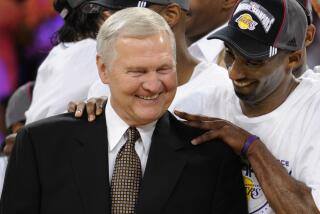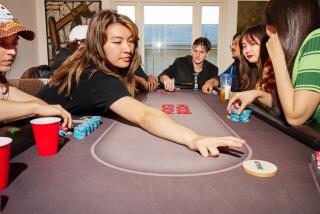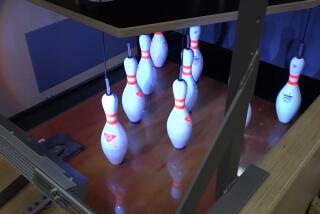He’s Got Grip on the Custom Ping-Pong Paddle Market
The back streets near Compton are a long way from Shanghai, Seoul, Tokyo, Budapest and other places where table tennis is a major sport.
But nestled on one of those streets near the western edge of town is the home of James D. West, who assembles customized paddles that have earned him a loyal following among Southern California’s circle of about 500 serious table tennis players.
“I would like to feel it’s because I’m good,” West said. “But maybe it’s like the crap game that everybody knows is crooked, but they go anyway because it’s the only game in town.”
West is one of the few people in the Los Angeles area who can whip together what a pro would call an inverted dimple defensive model for a person with a pinhole grip, all in less than five minutes.
Known and Respected
It’s not because he lacks competitors that he gets business. “There are other (assemblers) around,” said Dick Badger, president of the Long Beach Table Tennis Club. “But (West) prospers because he has the greatest reputation.”
A lanky, graying man of 61 with a friendly manner, West is a Crenshaw High School guidance counselor during the workday. But by preference, he is a devotee and oral historian of table tennis.
The parlor of West’s home is his workshop and showroom. There are four filing cabinets filled with table tennis paddles, and a corner shelf is stuffed with balls and nets.
“When I first came out to Los Angeles from Oklahoma with my father in 1938, I would follow my cousin over to McKinley School (now Carver Elementary),” West said. “School was still in session, so I would watch some people on the playground playing Ping-Pong. My father bought us a set before we went back to Oklahoma and we would play on the dining room table.”
Game Falls Short
After three years in the Army and four in college, always honing his game during idle hours, West returned to Los Angeles in the early 1950s to find that playing professionally was not a possibility for him.
“I heard about a pro-type club that was over on Highland,” he said. “That was the first time I had ever seen good table tennis. What I had been playing was Ping-Pong,” a term he uses almost derisively.
“I started going to tournaments and I quickly realized that I was not a championship-caliber player,” West said. “So I had to find a new niche.”
He realized that there was no place locally for good players to buy top-notch equipment. So he began his business.
The only time it looked like his business might suffer was when table tennis was at its peak of popularity in this country.
No Bonanza for Him
With President Richard M. Nixon opening doors to China by sending over a U.S. table tennis team in 1971, major department and sporting goods stores began stocking quality supplies in anticipation of a boom in the sport.
“It looked like table tennis was going to be a big thing, and all of the companies that had avoided it like the plague began opening up factories to make the equipment,” West said. “Little people like myself got pushed off to the side.”
But that boom proved to be a passing fad, and within a year, Americans had returned to thinking of table tennis as recreation-room fare.
Tournament-level players come to West because, like serious golfers, they want specific qualities in their equipment that they can’t buy off the rack.
Using different size and shape paddles and types of dimpled rubber sheeting, both of which he imports from the Far East, West is able to customize a paddle to meet a player’s style. Prices can run to $125, “as much as a tennis racket,” West said.
Grip Is the Thing
“The first thing I want to know from a player is if he has a pinhole or a shake-hand (common) grip,” he said. In the pinhole grip, popular among Asian players, a player holds the paddle handle between the index and middle fingers with its head pointed down.
More to Read
Go beyond the scoreboard
Get the latest on L.A.'s teams in the daily Sports Report newsletter.
You may occasionally receive promotional content from the Los Angeles Times.










